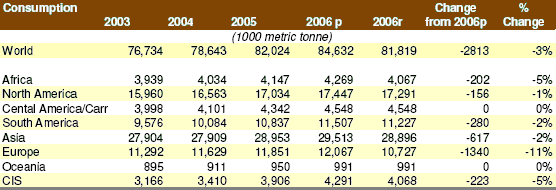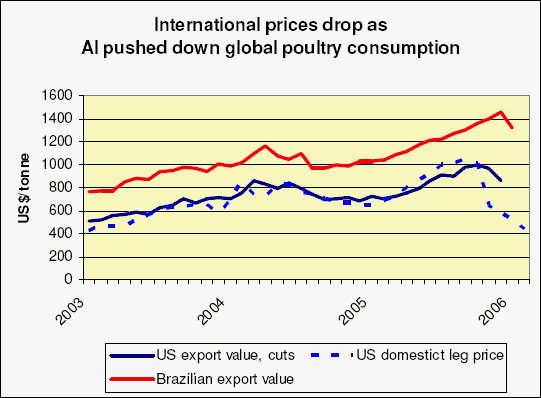



Global Poultry trade prospects for 2006 (updated)
By FAO - As outbreaks of avian influenza in wild swans in Europe are reported, global poultry markets have witnessed immediate and dramatic consumer responses, an increased number of trade bans and sharp reductions in prices. Unlike in 2004 and most of 2005 when the AI consumption impact was largely restricted to the Asian region, new AI detections in February 2006 in more than 12 nations in Africa, the Near East and Europe have resulted in immediate and pronounced consumption declines in importing countries in Europe, the Middle East and Central Asia.
At the onset of avian influenza outbreaks in 2004, lagging consumption in Asia and the loss of export markets for regional supplies led to an 8 percent decline in international trade. Over two years, as countries spared from the disease moved to fill the gap in supplies, poultry prices in international markets rose by over 30 percent. In contrast, early year developments in 2006 indicate a very different market environment. Irrespective of whether the outbreaks are identified in wild birds or in commercial flocks, the plummeting of consumption is progressively lowering global import demand for broiler parts. This sharp change in demand in a context of adequate supplies has put poultry prices under considerable downward pressure in the short term. This will affect industry profitability negatively and erode household livelihood and rural employment opportunities around the world.
FAO poultry consumption projections for 2006 lowered by 3 million tonnes
Revised FAO projections for 2006 assume a continuation of the current AI crisis, which
implies extended poultry consumption shocks in many affected countries in Europe, Middle
East and Africa. Declining international and domestic poultry prices are expected to restrict
production growth as eroding average per capita poultry consumption will push down global
poultry consumption in 2006. This projection is currently estimated nearly 3 million tonnes
lower than the previous 2006 estimate of 84.6 million tonnes1, to a level lower than that of
2005.
Projected change from previous 2006 estimate

Responses among European consumers to H5N1 avian influenza found in wild bird flocks has been variable, with consumption shocks ranging from a dramatic 70 percent decline in Italy in mid-February to 20 percent in France to a more subdued 10 percent response in northern Europe. These responses are similar to those observed in Europe in late 2005 when consumer concern about AI outbreaks moving progressively westward from Asia contributed to an annual one percent drop in demand in the EU-15 in 2005.
Meanwhile, outbreaks have prompted European governments to implement wide-ranging containment measures that included establishing security zones, increased surveillance plans and requirements that outdoor poultry be kept indoors. Policy responses from third countries to the EU discovery of AI in wild birds have ranged from bans on imports from the Union while some infected countries, such as Romania, have increased tariffs to support local prices as consumption drops. In Africa, consumers in the affected countries such as Egypt and Nigeria are moving away from poultry and egg products as are consumers in surrounding non-affected countries. Meanwhile, in India reports of consumption drops of 25 percent have caused a 12-13 percent fall in domestic prices, depressing production prospects.
Poultry prices plummet on the heels of consumption declines
Sharp reductions in international poultry prices, as consumption lags, are raising uncertainty
among exporters about trade prospects in 2006, previously estimated by FAO at 8.6 million
metric tonnes. In both Brazil and the United States, suppliers of approximately 70 percent of
global poultry trade, market indicators reveal the short term impact of consumption shocks
around the world. In the United States, export prices for broiler cuts, after rising to record
levels in October, dropped 13 percent over the remainder of the year as a result of weakening
export demand, evidenced in declining shipments to countries in Eastern Europe and Central
Asia in November and
December.

Meanwhile, recent market reports of plummeting domestic prices for US leg quarters 2 portend further reduction in export prices. While the US exports increased in 2005, sluggish international consumer demand later during the year in the context of most pervasive outbreaks of AI in Europe has led to a surge in US poultry stocks (with exportable chicken cuts in cold storage estimated up three fold from this time last year). Meanwhile in Brazil, where approximately 30 percent of total poultry output are exported, the price of day-old chicks, an early warning indicator of potential production changes, is reported to be down 50 percent.
Poultry trade shocks likely
As consumers look for alternatives to poultry, global trade prospects are expected to worsen
from the 10 percent gains witnessed in 2005. FAO global poultry trade projection has been
revised down 500 000 tonnes from the previous estimate of 8.6 million tonnes and below
shipments in 2005. The newly affected regions to-date, Europe, some areas of Central Asia
and the former Soviet Union, as well as parts of Africa represent approximately one-third of
the global poultry import market3. These projections, however, are largely dependent on the
geographic spread of AI and the pervasiveness of consumer concerns, in particular their
perspectives on the safety of imported meat compared to domestically available product.

Sharp poultry price declines around the world are leading to lower chicken placements in many affected countries, pushing FAO’s production projection down to 8.2 million tonnes, marginally higher than in 2005. In countries such as Iraq and Turkey where AI have caused human victims , production losses are reported to be massive. For example, it is reported in Iraq that only 10 percent of the nearly 500 semi-commercial farms continue to be operational. Even in countries where the disease has not been detected, such as Brazil, market uncertainties and lower prices have prompted the industry’s main producers to reduce production by 15 percent this year. Loss of income by backyard producers in many developing countries is escalating livelihood and food security risks while lower production prospects are also leading to some curtailing of contracts for temporary poultry workers. In Nigeria, the recent outbreak of AI in northern States has led not only to some producers losing their means of livelihood, as birds are culled and prices drop, but employees on farms are losing their jobs.
Meanwhile, the impact of the crisis is not limited to the poultry sector but has ripple effects into other sectors, with the $42 billion dollar feed sector in Europe citing demand losses of up to 40 percent in some countries.
The duration and overall extent of the market impact of recent AI detections will heavily depend on currently erratic consumer perceptions about human health risks. These concerns will be heavily influenced and shaped by government risk communication strategies and media coverage which should emphasize the safety of eating poultry products when properly cooked.
¹ The consumption projections are provisional based on market developments in early 2006 and depend heavily on the location and frequency of outbreaks in the short term.
² US leg quarter prices are down 50 percent from near record highs in early October 2005 of $.49/pound to a three year low of $. 23/pound in mid-February
³ In 2005, Europe, Africa, and CIS countries accounted for a respective 12%, 8% and 23 % of poultry imports.
Source: Food and Agriculture Organization (FAO) - February 2006








